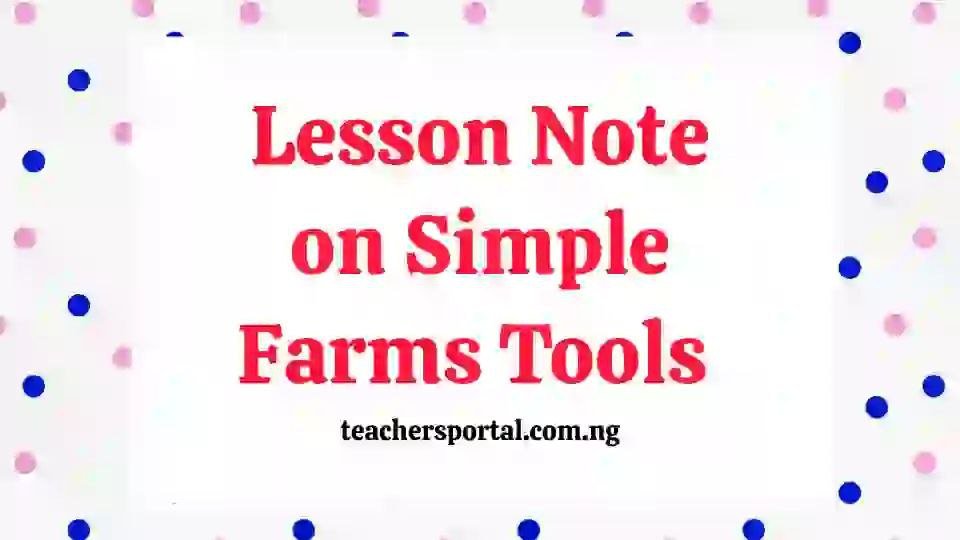Lesson Title: Simple Farm Tools
Time: 45 minutes
Lesson Objectives
By the end of the lesson, pupils will be able to:
- Define what a farm tool is.
- Identify different types of simple farm tools.
- Explain the uses of different simple farm tools.
- Categorize simple farm tools according to their functions.
- Compare and contrast different types of simple farm tools.
- Create a model of a simple farm tool.
Learning Materials
- Pictures or models of simple farm tools
- Worksheets on simple farm tools
- Construction materials (such as wood, nails, and string)
Content
Farm tools are special tools that farmers use to help them with different tasks on the farm. These tools make it easier for farmers to plant, grow, and harvest crops, as well as take care of animals. Examples of farm tools include shovels for digging, rakes for collecting leaves, hoes for loosening soil, and watering cans for giving plants water. These tools help farmers do their work more efficiently and effectively.
- Types of Simple Farm Tools
Here are some different types of simple farm tools:
- Shovel: A tool used for digging, lifting, and moving soil or other materials.
- Rake: A tool with a row of teeth used to gather leaves, hay, or other debris.
- Hoe: A tool with a flat blade used for breaking up soil, weeding, and cultivating the ground.
- Pitchfork: A tool with several pointed tines used for lifting and moving hay, straw, or other materials.
- Wheelbarrow: A small cart with a single wheel used to transport materials like soil, compost, or harvested crops.
- Watering Can: A container with a spout used to water plants and crops
- Pruning Shears: Sharp scissors-like tools used to trim and cut plants, bushes, and small branches.
- Garden Fork: A tool with broad tines used for turning over soil, breaking up clumps, and aerating the ground.
- Secateurs: Small handheld pruners used for trimming and shaping plants.
- Trowel: A small hand tool with a pointed blade used for planting, transplanting, and digging small holes.
- Plow: A tool used to turn over and break up the soil before planting crops. It helps create furrows for planting.
- Scythe: A curved blade attached to a long handle, used for cutting grass, hay, and other vegetation.
- Seed Drill: A tool used for planting seeds at a consistent depth and spacing, which helps in efficient and uniform crop growth.
- Sickle: A small, curved tool with a sharp blade used for harvesting crops like grains and grasses.
- Milking Pail: A container used for collecting milk from cows or other milk-producing animals.
- Simple Farm Tools According to Their Functions
- Soil Preparation
- Shovel
- Rake
- Hoe
- Garden Fork
- Plow
- Planting and Seeding
- Seed Drill
- Trowel
- Cultivation and Weeding
- Hoe
- Garden Fork
- Harvesting
- Pitchfork
- Scythe
- Sickle
- Transport and Handling
- Wheelbarrow
- Watering
- Watering Can
- Pruning and Trimming
- Pruning Shears
- Secateurs
- Livestock Care
- Milking Pail
Each of these categories represents a specific function that these farm tools serve. Farmers use these tools to carry out various tasks to ensure the successful growth of crops and the care of livestock on the farm.
- Comparison and contrast of different types of simple farm tools:
- Shovel vs. Hoe
Shovel: Used for digging, lifting, and moving soil. Has a wide, flat blade.
Hoe: Used for breaking up soil, weeding, and cultivating. Has a flat blade with a sharper edge.
- Rake vs. Garden Fork
Rake: Used for gathering leaves and debris. Has a row of teeth.
Garden Fork: Used for turning over soil, breaking clumps, and aerating. Has broad tines for digging.
- Pitchfork vs. Scythe
Pitchfork: Used for lifting and moving hay or straw. Has pointed tines.
Scythe: Used for cutting grass, hay, and vegetation. Has a curved blade attached to a long handle.
- Wheelbarrow vs. Watering Can
Wheelbarrow: Used for transporting soil, compost, or harvested crops. Has a single wheel and a tray.
Watering Can: Used for watering plants and crops. Has a spout for controlled pouring.
- Pruning Shears vs. Sickle
Pruning Shears: Used for trimming and cutting small plants and branches. Has a scissor-like mechanism.
Sickle: Used for harvesting grains and grasses. Has a curved, sharp blade.
These tools have different designs and purposes, but they all help farmers perform specific tasks on the farm. Some are designed for moving materials, others for cultivating soil, and still others for tending to plants and animals.
Procedure
- Begin by reviewing the different types of simple farm tools. Show pictures or models of the tools and ask students to name them.
- Explain the uses of the different simple farm tools. How are they used to prepare the soil, plant seeds, remove weeds, and harvest crops?
- Categorize the simple farm tools according to their functions. Have students work in groups to sort the tools into different categories.
- Compare and contrast different types of simple farm tools. Have students work in pairs to compare and contrast two different types of simple farm tools.
- Have students create a model of a simple farm tool. They can use construction materials to build their model.
Evaluation
- Defined basic farm tools?
- Identify and name the following farm tools.
- List the groups or classifications of the basic farm tools.
Conclusion
What are the uses of cutting tools, digging tools, and carrying tools?
Assignment
The teacher gives learners a take-home assignment to draw, color, and label five basic farm tools they know.
